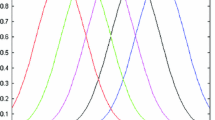Abstract
This paper presents a novel inverted fuzzy decoupling scheme for multi-input multi-output (MIMO) systems with disturbance via PI controller. The emphasis is to determine a decoupling control where specific inputs and outputs are paired. This decoupling control is achieved using fuzzy logic, to reduce the reliance on model-based analysis. The inverted decoupling approach allows more flexibility in choosing the transfer functions of the decoupled apparent process. In addition, the expressions of the inverted decoupling are presented for general \(n \times n\) processes, highlighting that the complexity of the decoupling elements is independent of the system size. The inverted fuzzy decoupling scheme is developed and compared with an ordinary inverted decoupling scheme. Based on the direct Nyquist array method, the stability conditions of the overall closed loop MIMO system in the presence of disturbance are formulated. A case study of Wood and Berry model of a binary distillation column is used to illustrate the applicability of the proposed schemes.




















Similar content being viewed by others
References
Belarbi, K., Belhani, A., & Fujimoto, K. (2006). Multivariable fuzzy controller based on a compensator of interaction and genetic tuning. International Journal of Innovative Computing, Information and Control, 2(1), 1207–1217.
Fadhil, D. (2011). Decoupling control of fluid catalytic cracking unit. Journal of Chemistry and Chemical Engineering, 5(1), 12–19.
Florentina, S. (2005). Decoupling in distillation. Control Engineering and Applied Informatics, 7(1), 10–19.
Garrido J, Vázquez, F., & Morilla, F. (2011). An extended approach of inverted decoupling. Journal of Process Control, 21(1), 55–68.
Garrido, J., Vázquez, F., & Morilla, F. (2013). Centralized inverted decoupling control. Industrial & Engineering Chemistry Research, 52(23), 7854–7866.
Garrido, J., Vázquez, F., & Morilla, F. (2015). Smith predictor with inverted decoupling for square multivariable time delay systems. International Journal of Systems Science, 47(2), 374–388.
Khelassi, A., Wilson, J. A., & Bendib, R. (2004). Assessment of interaction in process control systems. Proceedings of Dynamical Systems and Applications (pp. 463–471). Turkey: Antalya.
Kumar, S., & Kundu, M. (2013). Decoupling multivariable processes using partial least squares for decentralized control. International Journal of Computer Applications, 64(5), 5–12.
Lamamra, K., Belarbi, K., & Mokhtari, F. (2007). A fuzzy compensator of interactions for a multivariable generalized predictive control. International Journal of Sciences and Techniques of Automatic Control & Computer Engineering, 1(1), 236–245.
Liu, X. W., & Dai, T. F. (2012). Design for fuzzy decoupling control system of temperature and humidity. Advances in Electronic Engineering, Communication and Management, 140(2), 231–236.
Luyben, W. L. (2006). Distillation design and control using aspen simulation: Handbook of laboratory distillation. Hoboken: Wiley.
Mazinan, A. H., & Kazemi, M. F. (2012). Analysis and control of a high-purity distillation column system. Transactions of the Institute of Measurement and Control, 346(8), 1008–1018.
Razzaghi, K., & Shahraki, F. (2009). A Survey for the selection of control structure for distillation columns based on steady state controllability indexes. Iranian Journal of Chemical Engineering, 6(2), 29–36.
Sinnott, R. K., & Towler, G. (2008). Chemical engineering design. Amsterdam: Elsevier.
Skogestad, S. (1997). Dynamics and control of distillation columns a tutorial introduction. Transaction of IChemE, 75, 539–562.
Tong, H., Zhao, X., & Liang, G. (2012). Design and simulation of fuzzy decoupling for combustion process of circulating fluidized bed boiler. Advances in Electronic Engineering, Communication and Management, 140(2), 137–143.
Truong, H. S., Ismail, I., & Razali, R. (2010). Fundamental modeling and simulation of a binary continuous distillation column. International conference on intelligent and advanced systems (ICIAS), 15–17 June, Kuala Lumpur, pp. 1–5.
Vázquez, F., & Morilla, F., (2002). Tuning decentralized PI controllers for MIMO systems with decouplings. In IFAC 15th triennial world congress, Barcelona, Spain, pp. 137–137.
Wang, Q. G. (2003). Decoupling control. Berlin: Springer.
William, L. L. (2013). Distillation design and control using aspen simulation. Hoboken: Wiley.
Wood, R., & Berry, M. (1973). Terminal composition control of a binary distillation column. Chemical Engineering Science, 28, 1707–1717.
Zhu, Y., & Liu, X. (2005). Dynamics and control of high purity heat integrated distillation columns. Industrial & Engineering Chemistry Research, 44(23), 8806–8814.
Acknowledgments
The authors would like to thank Eng. I. Hamdan, of Menoufia University, for his help, as well as the Editor-in-Chief, and the anonymous reviewers for their inspiring encouragement and constructive comments, which have contributed much to the improvement of the clarity and presentation of this paper.
Author information
Authors and Affiliations
Corresponding author
Rights and permissions
About this article
Cite this article
Hamdy, M., Ramadan, A. & Abozalam, B. A novel inverted fuzzy decoupling scheme for MIMO systems with disturbance: a case study of binary distillation column. J Intell Manuf 29, 1859–1871 (2018). https://doi.org/10.1007/s10845-016-1218-x
Received:
Accepted:
Published:
Issue Date:
DOI: https://doi.org/10.1007/s10845-016-1218-x




